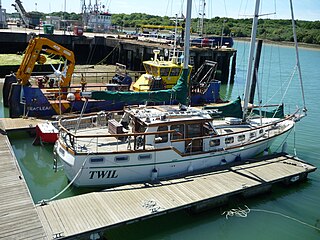Related Research Articles

The Bayfield 30/32 is a Canadian sailboat, that was designed by Ted Gozzard as a cruising boat and first built in 1973.
The Landfall 43 is a Canadian sailboat that was designed by Robert W. Ball, the chief designer of C&C Design, and first built in 1982. The Landfall 43 was built with the charter trade in mind, to compete with Morgan and Whitby’s centre cockpit models. The Landfall series, begun with the Landfall 43's predecessor the Landfall 42, was part of a trend within C&C Yachts during the later 1970s and early 1980s to develop more cruising-oriented designs under company president George Cuthbertson's direction.
The Contest 32 CS is a Dutch sailboat that was designed by Dick Zaal as an International Offshore Rule racer to Lloyd's rules and first built in 1978.
The Watkins 32 is an American sailboat that was designed by William H. Tripp Jr as a cruiser and first built in 1982.
The Seidelmann 37 is an American sailboat that was designed by Bob Seidelmann as a racer-cruiser and first built in 1980.
The Dickerson 37 is an American sailboat that was designed by George Hazen as a cruiser and first built in 1980.
The Endeavour 37 is an American sailboat that was designed by Dennis Robbins as racer-cruiser and first built in 1977.
The Shannon 38 is an American sailboat that was designed by Walter Shultz, plus George Stadel III and George H. Stadel Jr. of G, H. Stadel & Son as a cruiser and first built in 1975.
The Corbin 39 is a Canadian sailboat that was designed by Robert Dufour and Marius Corbin as a global circumnavigation cruiser and first built in 1979.
The Nautical 39 is an American sailboat that was designed by Charles Morgan and Roger Warren as a cruiser and first built in 1979.
The Islander 40 is an American sailboat that was designed by Doug Peterson as a racer-cruiser and first built in 1979.
The Endeavour 40 is an American sailboat that was designed by Robert K. Johnson as a cruiser and first built in 1981.
The Dickerson 41 is an American sailboat that was designed by Ernest Tucker as a cruiser and first built in 1973.
The Lord Nelson 41 is an American sailboat that was designed by Loren Hart as a cruiser and first built in 1982.
The Morgan Out Island 41 is a family of American sailboats that was designed by Charley Morgan for cruising and first built in 1971.
The Nimbus 42 is a Swedish sailboat that was designed by Americans F. Michael Kaufman and Robert Ladd as a cruiser-racer and first built in 1981.
The Irwin 41 is an American sailboat that was designed by Ted Irwin as a cruiser and first built in 1982.

The Nauticat 44 is a Finnish motorsailer sailboat that was designed by Kaj Gustafsson as a cruiser and first built in 1974.
The Worldcruiser 44 is an American sailboat that was designed by Bud Taplin as a cruiser and first built in 1980.
The Bayfield 36 is a Canadian sailboat that was designed by Haydn Gozzard for cruising and first built in 1984.
References
- 1 2 3 4 5 McArthur, Bruce (2020). "Bayfield 40 sailboat". sailboatdata.com. Archived from the original on 31 May 2020. Retrieved 30 May 2020.
- 1 2 3 4 5 6 7 8 Sherwood, Richard M.: A Field Guide to Sailboats of North America, Second Edition, pages 378. Houghton Mifflin Company, 1994. ISBN 0-395-65239-1
- ↑ Browning, Randy (2020). "Ted Gozzard". sailboatdata.com. Archived from the original on 29 May 2020. Retrieved 29 May 2020.
- ↑ McArthur, Bruce (2020). "Bayfield Boat Yard Ltd. (CAN)". sailboatdata.com. Archived from the original on 26 May 2020. Retrieved 26 May 2020.